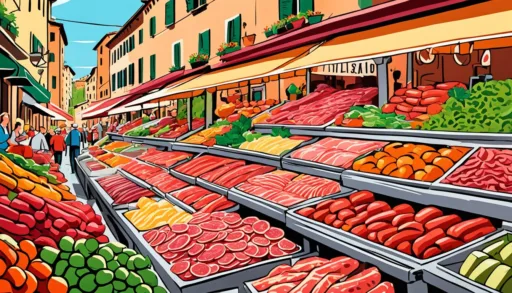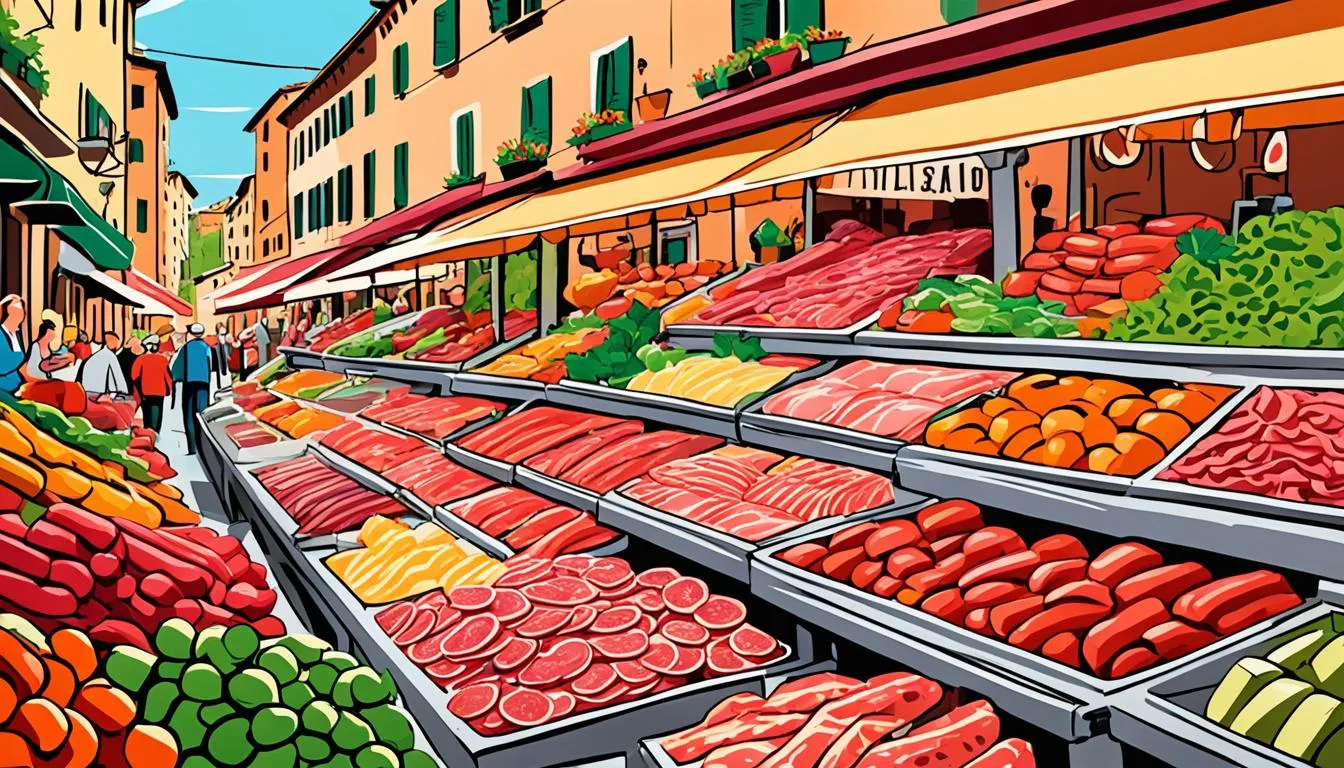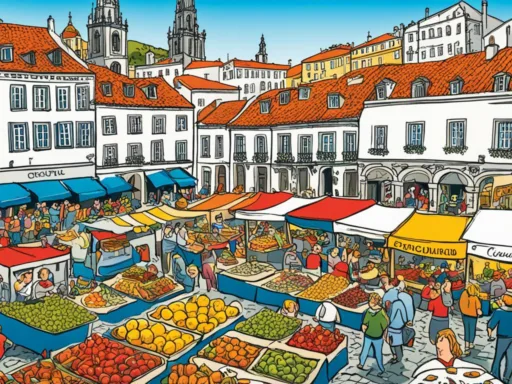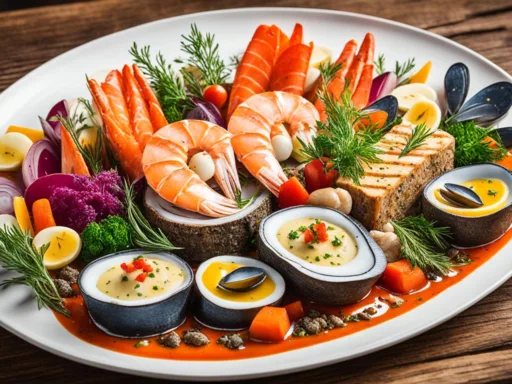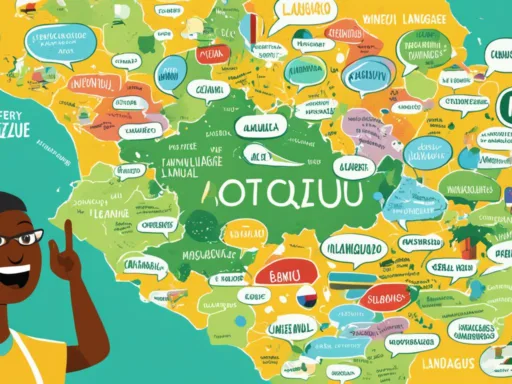Did you know that Italian cuisine was voted the world’s favorite cuisine in a global survey of over 25,000 people? This culinary powerhouse has conquered palates across the planet, signaling a universal love affair with the flavors of Italy. Embark on an Italian Dishes Tour that promises more than just a meal; it’s a passport to the diverse and rich tapestry of Italian cuisine. Whether you’re seeking a culinary tour in Italy or a local food tour in Italy, each dish tells a story—a history of regions, battles, and love woven into every bite.
Imagine yourself in a buzzing Italian piazza, embracing the Italian cooking experience that locals have cherished for centuries. Delight in authentic Italian food tours that connect you with the very soul of Italy’s gastronomic wonders. As you explore Italian gastronomy, you’ll encounter the warmth of its people and the zest of its flavors. Sophistication and simplicity fuse beautifully on an epic taste of Italy tour, guided by tradition and innovation at every step. Come along on guided food tours in Italy that will inspire your culinary curiosity and impassion your taste buds with every inviting meal.
Key Takeaways
- Italian cuisine’s global popularity reflects its excellence and universal appeal.
- A culinary journey in Italy is not only about food but also about experiencing cultural history.
- Authentic Italian food tours offer a chance to appreciate Italy’s regional and historical gastronomic distinctions.
- Exploring Italian gastronomy involves discovering the intimate connection between Italian culture and its culinary practices.
- Guided food tours in Italy provide a unique opportunity to taste and learn about local specialties firsthand.
- An Italian cooking experience can deepen one’s understanding of the timeless techniques and fresh ingredients that define Italian cuisine.
A Historical Perspective: The Origins and Evolution of Italian Cuisine
Embarking on an Italian Dishes Tour is more than indulging in sumptuous tastes; it is a journey through history, exploring the rich tapestry that molded what we recognize today as one of the world’s most beloved cuisines. Each forkful is a foray into an era where cooking was a form of expression, discovery, and unification.
Roman Empire: The Cradle of Italian Culinary Traditions
The Roman Empire’s kitchens sowed the seeds for modern Italian gastronomy. These ancient gourmands were known for their lavish feasts and the first recorded compilations of their culinary experiments, like those by Marcus Gavius Apicius. Decadence ruled their tables, with an assortment of bread, wines, and the finest meats of the land and sea.
The Middle Ages: Regional Flavors Take Shape
Transitioning into the Middle Ages, Italian cooking found its soul in simplicity and divergence. Geographic isolation allowed individual regions to cultivate distinct culinary identities. Foods like pasta began to find their place in the Italian diet, no doubt influenced by the vibrant trade links with the Middle East.
Renaissance: The Gourmet Era of Italian Cooking
The Renaissance was a veritable reawakening of cultural and culinary arts. Italian tables welcomed the likes of potatoes and tomatoes, newly arrived from the New World, transforming the culinary landscape. Now-iconic dishes such as pizza and pasta with tomato sauce began to emerge, setting the stage for what we recognize as quintessential Italian cuisine.
Unification to Modernity: The Spread and Global Influence of Italian Food
The mosaic of Italian regional dishes began to merge into a more cohesive national identity during the country’s unification. As Italians emigrated across the globe, they carried with them their culinary heritage, sowing the seeds for the infectious spread of Italian cuisine. The taste of Italy tour not only offers an opportunity to explore this storied gastronomy but also to understand its global resonance.
Whether you are embarking on a culinary tour of Italy or savoring the comfort of Italian dishes from abroad, the historical insights gleaned elevate every bite. The invitation to dine is an invitation to partake in a tradition steeped in rich history, an experience that transcends the simple act of eating – it’s a core part of Italian identity.
Rome: A Gastronomic Powerhouse with Ancient Roots
The Eternal City is more than just a haven for history buffs; it is a paradise for gourmets in search of authentic Italian food tours. A food tour in Italy often begins in Rome, where ancient traditions have sculpted a cuisine renowned for its robust flavors and hearty dishes. Let’s delve into the time-honored staples that have been the sustaining force behind this gastronomic capital.
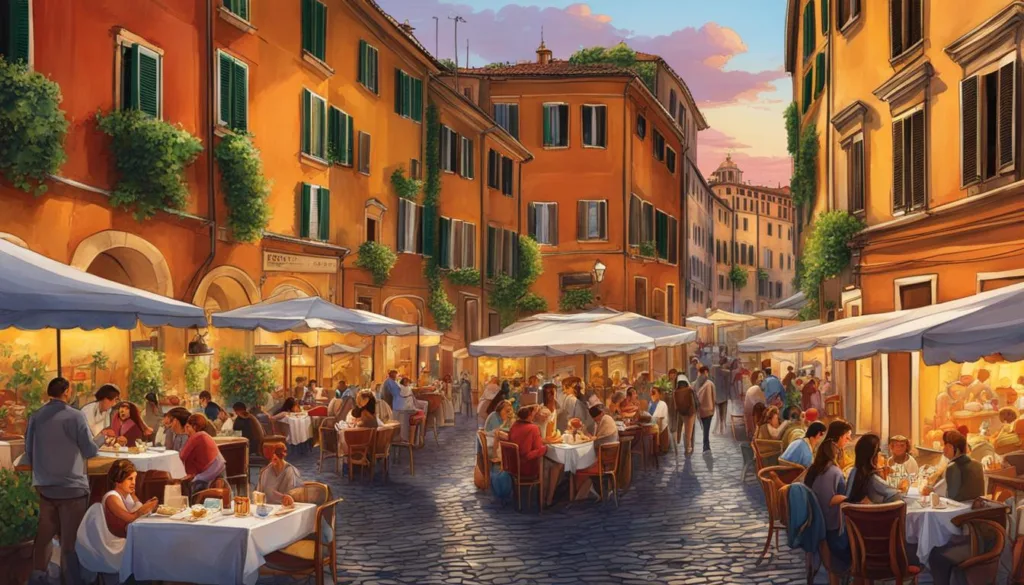
Rome’s culinary lore is a tapestry of history and ingredients from an empire that extended across Europe, Asia, and Africa. Its cuisine is a testament to Rome’s vast conquering reach, with dishes that incorporated a mosaic of flavors from across the Mediterranean and beyond. Let us explore the staples that still define Roman cuisine today:
| Dish | Main Ingredients | Historical Significance |
|---|---|---|
| Spaghetti Carbonara | Eggs, Pecorino Romano cheese, Guanciale | A post-war evolution of using abundant eggs and bacon supplied to Rome. |
| Cacio e Pepe | Pecorino Romano cheese, Black Pepper | Ancient Roman soldiers’ meal, utilizing long-lasting ingredients easy to transport. |
| Supplì | Rice, Tomato Sauce, Mozzarella | Originally devised from leftover risotto, it’s become a Roman street food staple. |
| Bruschetta al Pomodoro | Bread, Tomatoes, Garlic, Basil | An antipasto imbued with the flavors of Roman agriculture. |
The ingenuity of Roman dining is not confined to its past; the remnants of the Roman Empire’s grand feasting continue to echo throughout the city’s trattorias and dining tables. The modern Italian Dishes Tour is a culinary excavation, revealing the ceaseless bond between Rome and its abundant, flavor-filled heritage.
Partaking in authentic Italian food tours is not just about indulging in delightful flavors; it’s a historical pilgrimage. As one embarks on a food tour in Italy, especially within the cobbled lanes of Rome, they are retracing the steps of ancient Romans, savoring a cuisine that has evolved yet retains its deep connections to a rich and imperial past.
An Italian Dishes Tour: Delving into the Riches of Regional Cuisine
Embarking on a guided food tours Italy is a journey across a landscape rich with history, art, and unparalleled gastronomy. An Italian cuisine tour offers an enticing opportunity to explore the multifaceted nature of Italy’s culinary heritage. Each region presents its own anthology of flavors and stories, diligently crafted over centuries and ready to be discovered by the avid food lover.
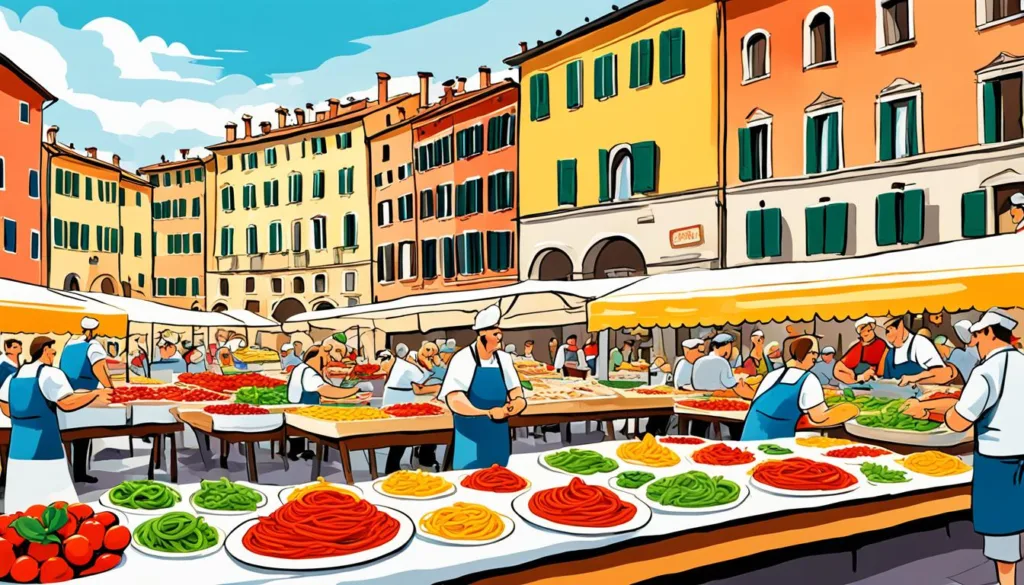
Imagine walking through the aromatic alleyways of Naples, each step you take immerses you deeper into the heart of passionate cooking and genuine hospitality. The air is laden with the scent of freshly baked bread, robust tomatoes, and the oceanic whispers carried from the Mediterranean. But this is merely the first course on our taste of Italy tour, promising a banquet of culinary delights, each with a narrative of their own.
Follow the breadcrumb trail of artisanal cuisine to unearth the sectional specialties that have become hallmarks of Italian culinary artistry:
- The legendary four Roman pastas, including the iconic Carbonara, each revealing the eternal city’s history through its sauces and shapes.
- Sicily’s robust and aubergine-rich Pasta alla Norma, a dish where the Mediterannean garden comes to life with every bite.
- Bologna’s luscious and creamy cheeses, showcasing the mastery of dairy artisans in the fertile plains of Emilia-Romagna.
- Tuscany’s sumptuous steaks, reflecting the region’s rustic charm and affinity for heartfelt, homely flavors.
“The discovery of a new dish does more for the happiness of the human race than the discovery of a star.” – Anthelme Brillat-Savarin
As every dish unveils its saga, participants on a guided food tours Italy realize they’re not just tasting food; they’re imbibing the spirit of Italia itself – a palette of countless epochs, each contributing a distinct brushstroke to the expansive mural of Italian cuisine.
| Region | Signature Dish | Key Ingredients | Historical Influence |
|---|---|---|---|
| Latium (Lazio) | Spaghetti alla Carbonara | Guanciale, Pecorino cheese, Eggs, Black pepper | Ancient Rome, pastoral tradition |
| Sicily | Pasta alla Norma | Eggplant, Tomatoes, Ricotta salata, Basil | Greek and Arab influence on agriculture |
| Emilia-Romagna | Parmigiano Reggiano | Cow’s milk | Medieval monastic practices |
| Tuscany | Bistecca alla Fiorentina | Chianina beef, Olive oil, Rosemary | Etruscan and Roman livestock farming |
Such an odyssey across Italy doesn’t just feed the body but also the soul, making any taste of Italy tour an unforgettable pilgrimage through the essence of flavors, time, and tradition. Whether you’re romanced by the simplicity of a Tuscan dish or intrigued by the complexity of a Sicilian recipe, a guided tour of Italy’s regional dishes is a testament to the enduring legacy and continued innovation of Italian cuisine.
The Cultural Fusion Behind Italian Gastronomy
Embark on a delectable voyage through the layered history of Italian cuisine—a testament to cultural symbiosis and gastronomic innovation. Adventurous souls eager to explore Italian gastronomy will discover a fascinating mosaic wrought from ages of exchange and evolution, an essential piece of any Italian cuisine tour. For both amateur food lovers and seasoned epicureans, engaging in an Italian cooking experience provides insight into a cuisine that embodies the grandeur of the past fused seamlessly with the zest of modernity.
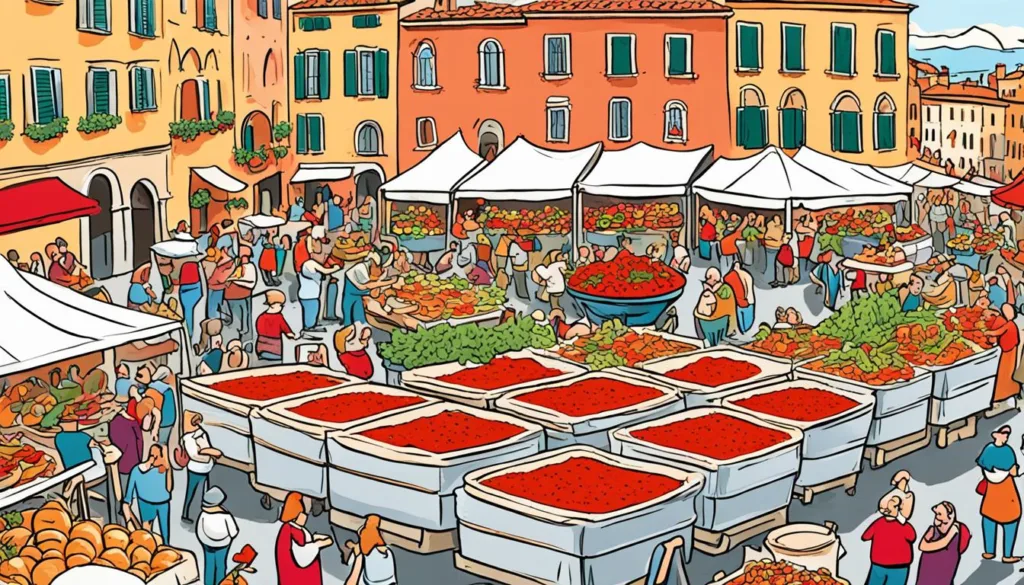
Italian cuisine offers more than just a meal; it offers a journey through time and place, where each dish narrates the confluence of various cultures.
External Influences and Their Impact on Italian Delicacies
The ports of Italy once bustled with traders from far and wide, bringing with them a bounty of exotic spices and unique cooking methods that would leave an indelible mark on Italian cooking. Sicilian cuisine, in particular, with its rich Arab influences, still dazzles with an array of spices and sweets that speak to the island’s diverse historical occupants. The very foundation of what we recognize today as Italian gastronomy is in many ways a patchwork quilt, each piece reflecting a different realm, a different era.
Fusing Old World and New World Ingredients
The Renaissance era was a pivotal point, a culinary crucible in which Old World tradition amalgamated with New World innovation. Prior to the Columbian Exchange, Italy had never seen the likes of tomatoes, maize, or peppers, but these ingredients swiftly went from foreign curiosity to the cornerstone of Italian cooking, redefining and enriching its palate. The inclusion of these foods was not just an evolution of taste, but a revolution in the cooking landscape that would echo through the generations to today’s beloved Italian dishes.
| Ingredient | Origin | Impact on Italian Cuisine |
|---|---|---|
| Tomato | New World (Americas) | Transformed sauces, becoming pivotal in dishes like Pizza Margherita and Pasta Pomodoro |
| Peppers | New World (Americas) | Enhanced the heat and flavor complexity of Italian cooking |
| Maize | New World (Americas) | Introduced polenta as a staple in Northern Italy |
| Spices (e.g., saffron) | Old World (Asia) | Enriched the aromatics of cuisine especially in regions like Sicily |
As we delve deeper into the annals of history, the threads of migration, conquest, and trade reveal themselves through the robust flavors and innovative techniques of Italian gastronomy. It is a testament to Italy’s historical importance that so many different tastes and traditions could weave together to create something that is celebrated across the globe for its heartiness and its ethos of sharing—a true hallmark of Italian dining culture.
Florence and Tuscany: The Heart of Rustic Italian Cooking
The essence of authentic Italian food tours can truly be embraced in the heartlands of Florence and Tuscany. Picture the region’s sprawling vineyards and olive groves providing a backdrop to a culinary tour Italy is famed for. The ethos of Tuscan cooking is a testament to the art of using simple, fresh ingredients to create dishes that nourish the soul and epitomize Italian culinary traditions.
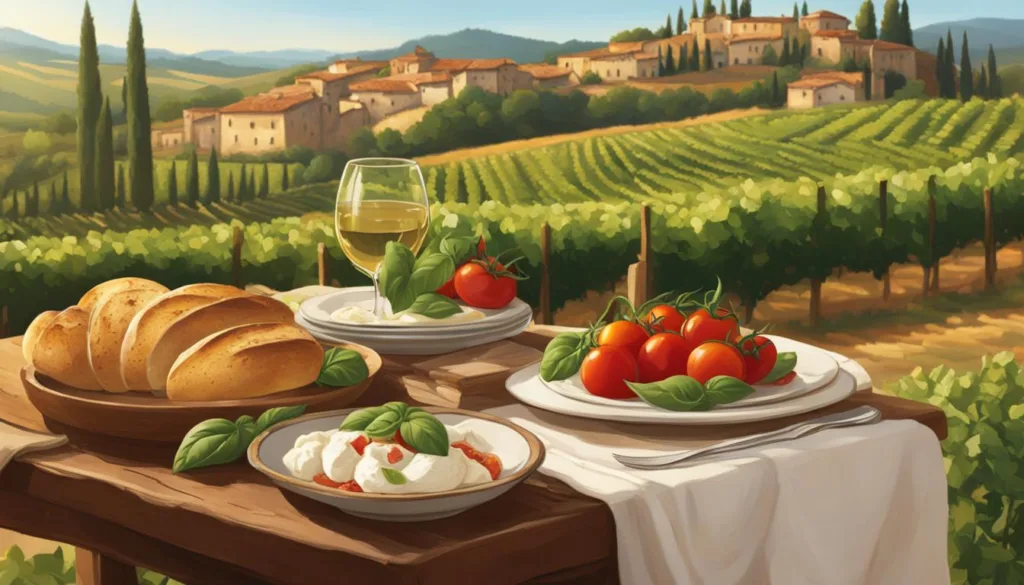
Tuscan dishes are unpretentious yet sublime—like the iconic Bistecca alla Fiorentina, a T-bone steak that’s always cooked over chestnut embers to give it a distinctive flavor. Or consider the ingenious panzanella, a summer salad that’s a delicious testament to Tuscan resourcefulness by making use of stale bread. It is these rustic, heartwarming dishes that an Italian Dishes Tour celebrates, ensuring each visitor finds an authentic slice of Italy to cherish.
The ingredients here speak for themselves and are homage to the region’s agricultural bounty. Whether it’s a chunk of crusty bread dipped in freshly pressed olive oil or a sip of the bold Chianti wine, each element is a brushstroke in the larger canvas of culinary tour Italy. It’s within Florence’s bustling markets and Tuscany’s serene farms that one experiences the intersection of history, art, and gastronomy.
- Florentine steak (Bistecca alla Fiorentina)
- Ribollita (Traditional Tuscan soup)
- Panzanella (Tuscan bread salad)
- Cantuccini with Vin Santo (Almond biscuits with sweet wine)
- Pecorino Toscano (Tuscan sheep’s cheese)
The appeal of these classic dishes lies not only in their hearty flavors but also in their cultural significance. Each meal serves as a conduit to Tuscany’s past—a history saturated with tales of feasts and famines, invasions and innovations, which have all played a role in shaping what we declare today as authentic Italian food tours. Engaging in an Italian Dishes Tour signifies more than just eating; it’s about immersing oneself in the lifestyle and spirit of Italy—one bite at a time.
Taste of Italy Tour: Sampling the Authentic Flavors
Embark on a food tour in Italy and immerse yourself in a culinary voyage that celebrates the rich and authentic flavors of this storied country. Experiencing a taste of Italy tour is not just about savoring the food; it’s about diving deep into the Italian cooking experience that marries tradition with sensory delight. Every bite and sip is a testament to Italy’s gastronomic legacy, conveyed through its vibrant foodscapes that offer a feast for the eyes, the palate, and the soul.
Imagine walking the cobblestone streets of Rome, where the aroma of fresh pasta mingles with the history that surrounds you. In Milan, chic aperitivos set the scene for an elegant evening, while the Amalfi Coast tempts with decadent desserts and the sparkling Mediterranean as a backdrop. Each region of Italy provides a distinctive culinary narrative, rich in history and bursting with flavor.
| Region | Specialty | Experience |
|---|---|---|
| Rome | Carbonara | Traverse the ancient city and revel in the creamy delight of Rome’s revered pasta. |
| Milan | Risotto alla Milanese | Indulge in this saffron-infused rice dish that reflects Milan’s luxurious food culture. |
| Amalfi Coast | Limoncello | Sip on Italy’s iconic lemon liqueur while gazing at the stunning Amalfi seascape. |
| Naples | Neapolitan Pizza | Witness the art of pizza making and taste authentic pizza in its birthplace. |
| Tuscany | Gelato | Explore the rolling hills as you enjoy a scoop of Italy’s famous frozen treat. |
| Sicily | Cannoli | End your tour with a sweet crunch of cannoli, the pride of Sicilian dessert. |
Join us on this taste of Italy tour where you’ll not only fill your plate but also enrich your understanding and appreciation of Italian culinary artistry. A journey woven with delectable treats and inspirational moments awaits every food lover who desires to capture the essence of Italy’s vibrant cooking traditions.
Italian Cuisine in the Modern Era: Innovation Meets Tradition
Amidst a rapidly changing world, the timeless appeal of Italian cuisine endures, blending age-old methods with modern twists. Today, authentic Italian food tours offer a window into how these traditional dishes are being reinvented while honoring their historic roots. This cultural phenomenon is not limited to Italy’s borders; across the globe, particularly within the flourishing Italian-American communities, there’s a vibrant effort to keep traditional flavors alive, all the while embracing contemporary culinary trends.
The Continuing Evolution of Classic Dishes
As chefs strive to balance innovation with tradition, classic Italian recipes are receiving makeovers that align with modern dietary trends and local tastes. Culinary pioneers on guided food tours in Italy reveal these evolved creations, showcasing the versatility and resilience of Italian gastronomy. Yet, the essence of simplicity—central to Italian cuisine—remains, instilling each dish with the familiar communal warmth that has long defined Italian dining.
The Role of Italian-American Cuisine in Preserving Heritage
In the bustling streets of New York, Chicago, and other cities with substantial Italian-American populations, the effort to preserve culinary heritage is evident in the numerous eateries and family-owned delis churning out traditional fare. These communities bridge the Atlantic, bringing forth an authentic Italian food experience that spans generations. It is in these spaces that the importance of gastronomy in maintaining cultural identity is most keenly felt, ensuring that the legacy of Italian cuisine continues to flourish far from its native land.
The Italian Cooking Experience: A Guide to Traditional Techniques
An Italian cooking experience isn’t simply learning recipes; it’s an immersion into the history and heart of Italian food. The secrets of Italian cuisine are passed down from generation to generation, cultivated through time to become the flavorful masterpieces known worldwide. One quintessential aspect of this rich culinary heritage is the art of pasta-making. Meticulously crafted and shaped by hand, pasta is the cornerstone of an authentic Italian Dishes Tour.
Beyond pasta, the Italian culinary landscape brims with traditional techniques that showcase the region’s dedication to flavor and simplicity. From the way mozzarella is stretched and formed in Campania, to the specific cuts of meats for Florentine steaks—each method contributes to the unmistakable identity of Italian cuisine.
| Region | Technique | Signature Dish |
|---|---|---|
| Tuscany | Al Mattone (Under a Brick) | Pollo al Mattone |
| Emilia-Romagna | Pasta Rolling | Tagliatelle al Ragù |
| Lombardy | Risotto Stirring | Risotto alla Milanese |
| Sicily | Sweet and Sour Cooking | Caponata |
On an Italian Cuisine Tour, enthusiasts not only taste but participate, engaging their senses and hands-on practice to understand the confluence of history, geography, and ingenuity. Such an experience connects food lovers to the rustic soils of Italy where these traditions originated.
To truly delve into the Italian cooking experience, one must observe locals, chefs, and artisans utilizing these techniques in their daily craft. An Italian Dishes Tour often includes visits to local markets, butcheries, cheese makers, and vineyards, providing a platform for learning and understanding Italian cooking from the ground up.
“Italian cooking is a symphony of flavors and techniques, each region playing a distinct tune that, when combined, creates a harmonious culinary masterpiece.”
In summary, an Italian cooking experience presents a profound opportunity to touch and taste the essence of Italy. It’s a hands-on exploration that goes beyond the palate and stirs the soul with every handcrafted dish.
Guided Food Tours Italy: A Journey Through Italian Culinary Landscapes
Embark on a delightful guided food tour in Italy, where each step opens the door to a world brimming with gastronomic treasures. These tours are not just about savoring the flavors, they’re a profound dive into a cultural legacy, a narrative told through the lens of exquisite cuisine. Whether it’s the bustling markets of Rome or the quiet cellars of Tuscany, the Italian dishes tour is an experience that weaves history, tradition, and taste into an unforgettable journey.
Exploring the Artisanal and Market-Fresh Produce
Italy’s markets are vibrant stages displaying the freshest of produce, where the true essence of Italian gastronomy begins. A stroll through these markets with knowledgeable guides opens up a world where every fruit, vegetable, and herb has a story—a testament to the land’s fertility and the people’s passion for food.
Cheese, Wine, and Olives: The Holy Trinity of Italian Flavor
As you traverse the picturesque landscapes on your food tour in Italy, you’ll discover the sacred triad that encapsulates the soul of Italian flavors: cheese, wine, and olives. Each element is a chapter in Italy’s culinary saga, from the sharp pecorino to the rich Chianti and the robust extra virgin olive oil, they represent Italy’s dedication to excellence and authenticity.
| Cheese | Wine | Olives |
|---|---|---|
| Pecorino | Chianti | Taggiasca |
| Gorgonzola | Barolo | Cerignola |
| Mozzarella di Bufala | Prosecco | Bella di Cerignola |
Conclusion
The extensive journey through Italian gastronomy reveals not just a mere assortment of dishes but a universal language that resonates with the hearts of people across the globe. With such a vast array of flavors intricately woven into its fabric, Italian cuisine represents a story of tradition, unity, and the shared joy of dining. It is a rich heritage that mirrors the evolution of society itself, and remains a cornerstone of cultural identity, embraced and celebrated in every corner of the world.
The Universality of Italian Cuisine: A Summary of Its Global Reach
As we’ve seen throughout our culinary exploration, the widespread love for Italian food emphasizes its ability to cross cultural divides, enhancing the global dining experience. The universal appeal of Italian cuisine lies in its ability to adapt while keeping true to the essence of its flavors. Whether it’s the simplicity of a Neapolitan pizza or the elegance of a Florentine steak, Italian dishes have secured a place at the global table, manifesting a communal spirit that bonds people regardless of geography.
Invitation to Explore Italian Gastronomy
The allure of Italian cuisine compels a continuous and immersive exploration. An open invitation stands for all culinary adventurers to partake in a taste of Italy tour, diving palate-first into the storied regions and bountiful plates Italy has to offer. Embarking on an Italian cooking experience is not just about savoring exquisite flavors but also about discovering the profound narratives interlaced within each dish. So, we encourage you to explore Italian gastronomy and join a community that spans beyond the mere enjoyment of food, celebrating a legacy richly flavored by history and human connection.
FAQ
What can I expect from an Italian Cuisine Tour?
An Italian cuisine tour offers a comprehensive dive into the country’s rich culinary tradition, from learning about the historical roots of popular dishes to tasting regional specialties. This immersive experience spans traditional cooking methods, local markets, vineyards, and cheese makers, and includes dining in authentic trattorias and learning from local chefs.
Are Food Tours in Italy suitable for vegetarians or individuals with dietary restrictions?
Yes, food tours in Italy can accommodate dietary restrictions with advanced notice. Italian cuisine has a variety of vegetarian options, and tour guides are typically eager to tailor the experience to meet the dietary needs of participants.
How does the Italian Cooking Experience vary by region?
Italian cooking varies immensely from region to region, reflecting the unique history, culture, and geography of each area. For example, Tuscany is known for its simple, hearty fare featuring fresh local ingredients like bread, cheese, and meat, while coastal regions offer a variety of seafood dishes. Each regional cooking experience is distinct and offers a different slice of Italian culinary life.
What makes Authentic Italian Food Tours different from regular sightseeing tours?
Authentic Italian food tours are specifically focused on the gastronomy of the regions visited. They provide a more hands-on, sensory-rich experience, often including cooking demonstrations, visits to food producers, and personal interactions with local chefs and artisans, revealing the story behind the flavors and recipes.
What is the significance of exploring Italian Gastronomy on a guided food tour?
Exploring Italian gastronomy on a guided food tour allows for a deeper understanding of the food’s cultural context. Knowledgeable guides share insights into the history, tradition, and techniques behind Italian dishes, offering a more engaging and in-depth experience than self-guided exploration.
How long do Taste of Italy Tours typically last?
Taste of Italy tours can vary in length depending on the itinerary, ranging from a few hours to multiple days. Shorter tours might focus on a specific meal or neighborhood, while longer tours might include several regions and a wide sample of Italian foods and wines.
Can I learn about Italian wine and cheese on these tours?
Yes, many guided food tours in Italy include tastings and education about the country’s famous wines and cheeses. You’ll have opportunities to visit vineyards, cheese farms, and meet with vintners and affineurs who explain their craft and the products’ distinctive characteristics.
Are Italian Dishes Tours family-friendly?
Italian dishes tours can be a wonderful experience for families, as Italian culture is very family-oriented. However, the suitability of a tour for children may depend on its duration and level of activity, so it’s best to check with the tour provider beforehand.
Will I get to try making pasta on these culinary tours in Italy?
Many culinary tours in Italy offer hands-on experiences, including pasta making. This can be a highlight for many participants, providing an authentic insight into the skills and techniques involved in creating one of Italy’s most famous foods.
Should I book my Italian food tour in advance?
It is generally recommended to book an Italian food tour in advance, especially during peak tourist seasons or if you’re interested in a tour with limited space. This ensures that you secure your spot and can help tour operators better prepare for any specific requests or needs.
